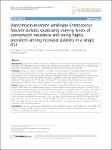Vancomycin-resistant vanB-type Enterococcus faecium isolates expressing varying levels of vancomycin resistance and being highly prevalent among neonatal patients in a single ICU
Werner, Guido
Klare, Ingo
Fleige, Carola
Geringer, Uta
Witte, Wolfgang
Just, Heinz-Michael
Ziegler, Renate
Background: Vancomycin-resistant isolates of E. faecalis and E. faecium are of special concern and patients at risk of acquiring a VRE colonization/infection include also intensively-cared neonates. We describe here an ongoing high prevalence of VanB type E. faecium in a neonatal ICU hardly to identify by routine diagnostics. Methods: During a 10 months’ key period 71 E. faecium isolates including 67 vanB-type isolates from 61 patients were collected non-selectively. Vancomycin resistance was determined by different MIC methods (broth microdilution, Vitek® 2) including two Etest® protocols (McFarland 0.5/2.0. on Mueller-Hinton/Brain Heart Infusion agars). Performance of three chromogenic VRE agars to identify the vanB type outbreak VRE was evaluated (BrillianceTM VRE agar, chromIDTM VRE agar, CHROMagarTM VRE). Isolates were genotyped by SmaI- and CeuI-macrorestriction analysis in PFGE, plasmid profiling, vanB Southern hybridisations as well as MLST typing. Results: Majority of vanB isolates (n = 56, 79%) belonged to a single ST192 outbreak strain type showing an identical PFGE pattern and analyzed representative isolates revealed a chromosomal localization of a vanB2-Tn5382 cluster type. Vancomycin MICs in cation-adjusted MH broth revealed a susceptible value of ≤4 mg/L for 31 (55%) of the 56 outbreak VRE isolates. Etest® vancomycin on MH and BHI agars revealed only two vanB VRE isolates with a susceptible result; in general Etest® MIC results were about 1 to 2 doubling dilutions higher than MICs assessed in broth and values after the 48 h readout were 0.5 to 1 doubling dilutions higher for vanB VRE. Of all vanB type VRE only three, three and two isolates did not grow on BrillianceTM VRE agar, chromIDTM VRE agar and CHROMagarTM VRE, respectively. Permanent cross contamination via the patients’ surrounding appeared as a possible risk factor for permanent VRE colonization/infection. Conclusions: Low level expression of vanB resistance may complicate a proper routine diagnostics of vanB VRE and mask an ongoing high VRE prevalence. A high inoculum and growth on rich solid media showed the highest sensitivity in identifying vanB type resistance.
Dateien zu dieser Publikation
Keine Lizenzangabe

